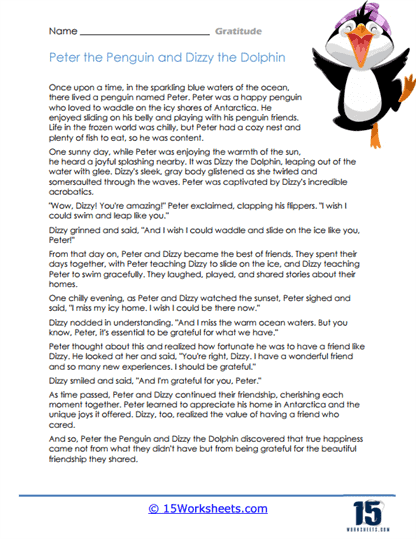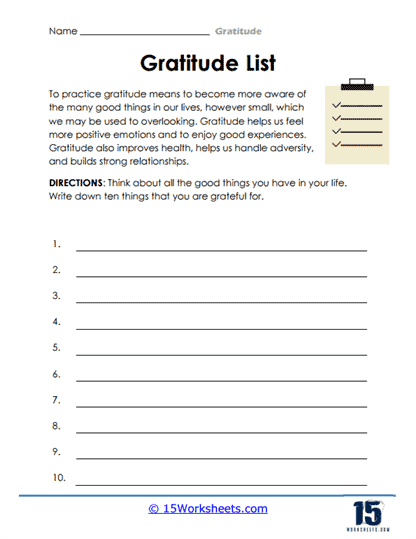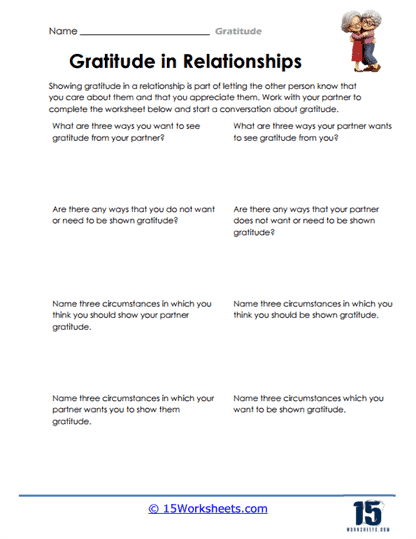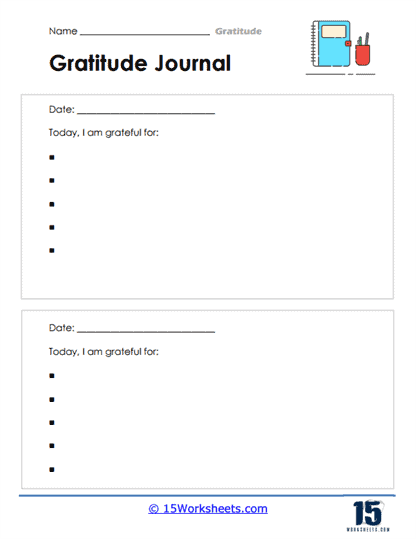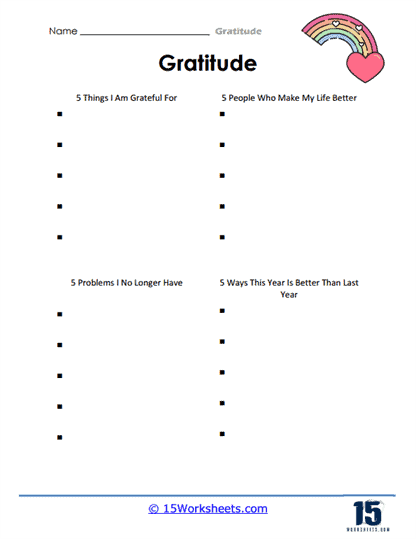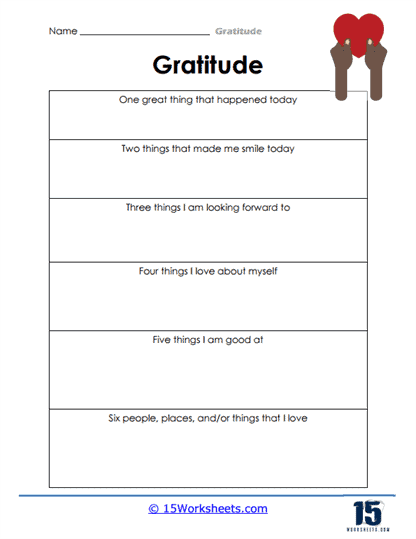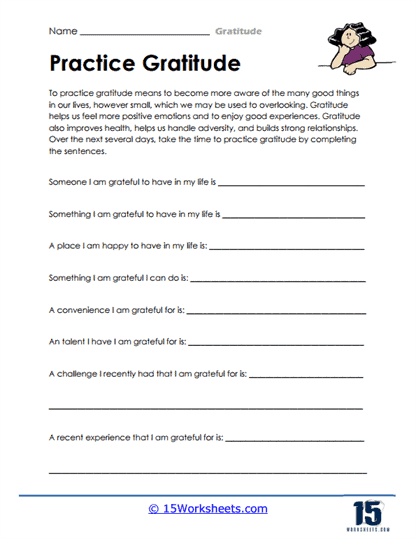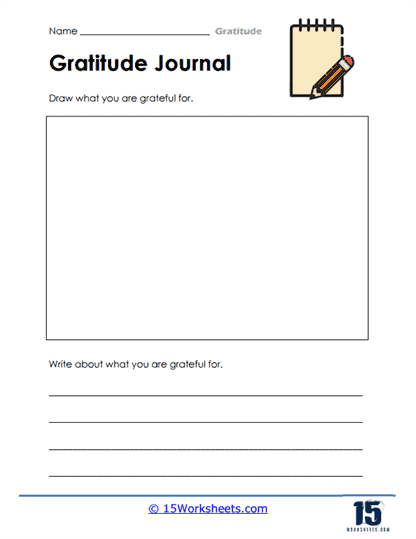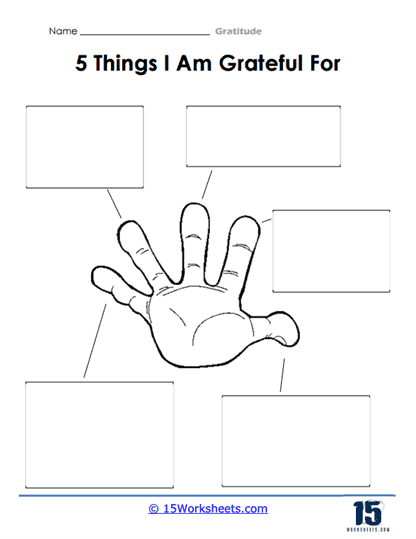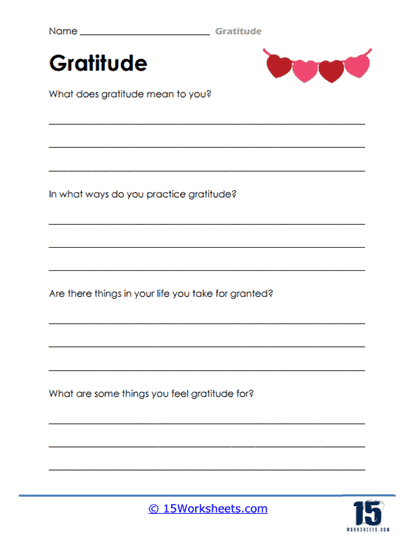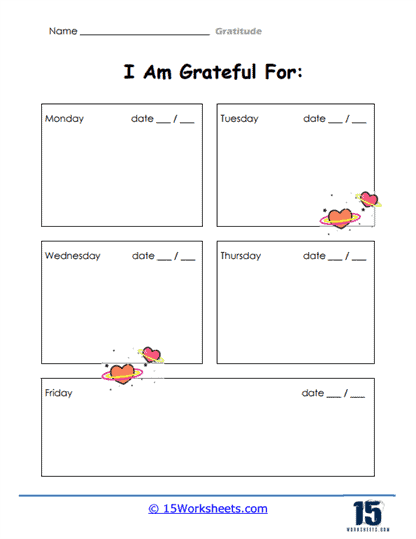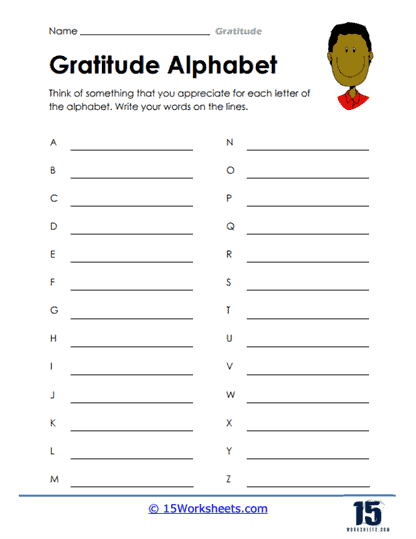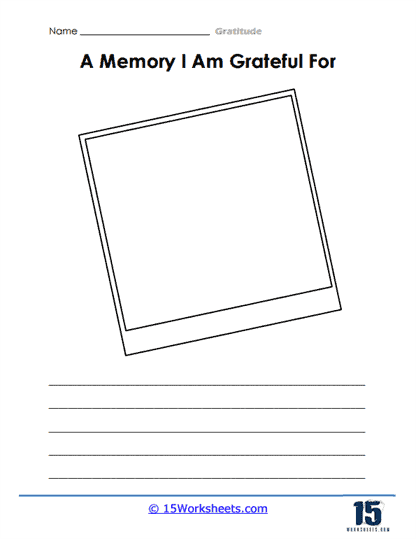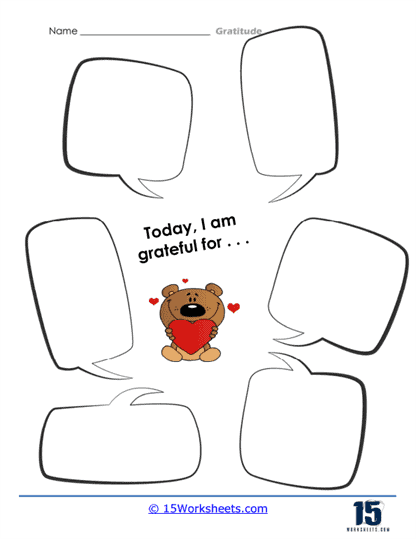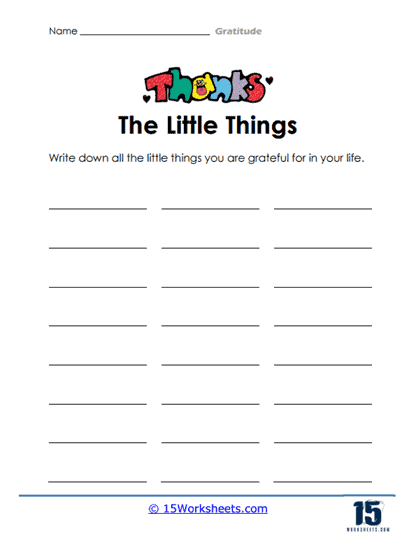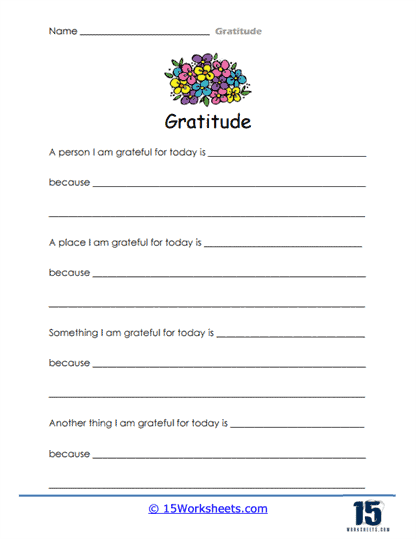Gratitude Worksheets
All About These Worksheets
Our gratitude worksheets are structured exercises designed to help individuals cultivate an attitude of thankfulness and appreciation in their daily lives. These worksheets typically contain prompts, activities, or questions that encourage reflection on positive aspects of one’s experiences, relationships, and environment. The goal is to shift focus away from stress, complaints, or negativity, and instead, help people become more mindful of the things they appreciate. Gratitude worksheets are often used in various therapeutic settings, such as cognitive-behavioral therapy, mindfulness training, and positive psychology interventions, but they can also be used independently by anyone looking to enhance their emotional well-being.
One common type of gratitude worksheet includes daily prompts that ask individuals to list three to five things they are grateful for each day. These items can range from significant life events to small, everyday moments, like enjoying a warm cup of coffee or receiving a kind message from a friend. This regular practice of acknowledging positive elements can lead to a more optimistic outlook, as it trains the mind to seek out and focus on the good, rather than dwelling on challenges or disappointments. Over time, this can help reshape an individual’s perspective, making it easier to handle stress and negativity.
Gratitude worksheets can also contain more detailed exercises, such as reflecting on a difficult experience and finding lessons or silver linings within it. This type of exercise is particularly useful for reframing past challenges, enabling people to see how adversity may have contributed to personal growth, increased resilience, or brought unexpected benefits. By encouraging a shift in how individuals view hardships, these worksheets foster a mindset of acceptance and learning rather than regret or resentment.
Another type of activity might involve writing a gratitude letter to someone who has made a significant positive impact on one’s life. This worksheet might ask the individual to describe specific actions that were meaningful, how those actions made them feel, and why they are thankful for the person. Writing and, when possible, delivering such a letter not only strengthens relationships but also provides a powerful reminder of the support systems and kindness that exist in a person’s life. Acts of expressing gratitude in this way can lead to improved mood, deeper connections, and greater life satisfaction.
The overall purpose of gratitude worksheets is to make gratitude a regular practice, embedding it into daily routines and thought patterns. The consistent practice of gratitude has been linked to numerous mental health benefits, including increased happiness, reduced symptoms of depression and anxiety, and improved physical health. Additionally, gratitude fosters a sense of contentment, making individuals more resilient when faced with life’s challenges. This simple yet impactful tool encourages people to be present and mindful, shifting their focus toward positivity and, ultimately, leading to a more fulfilling and balanced life.
Types of Exercises on Gratitude Worksheets
Gratitude Journals – One of the most popular tools, it involves writing down things for which one is thankful.
Example: A worksheet might provide spaces for individuals to list three things they are grateful for each day.
Teaching Objective: Regularly identifying and acknowledging positive elements in one’s life can shift focus from what’s lacking or negative, promoting a more positive and content mindset.
Gratitude Letters – Writing a letter to someone for whom one is thankful, even if it’s never sent.
Example: The worksheet could provide prompts to guide the letter-writing, such as memories or specific reasons for gratitude.
Teaching Objective: Helps individuals recognize the positive influences of others in their lives and fosters deeper, more meaningful connections.
Gratitude Reminders – Creating physical reminders to practice gratitude daily.
Example: A worksheet might guide users to design gratitude cards or tokens to place in visible spots, like a mirror or workspace.
Teaching Objective: Ensures consistent engagement with gratitude practices and infuses daily routines with moments of reflection and appreciation.
Gratitude Walks – Mindful walks where the primary aim is to observe and appreciate the surroundings.
Example: The worksheet might offer a checklist of things to notice, like the sound of birds, the feeling of sunshine, or the sight of something beautiful.
Teaching Objective: Grounds individuals in the present moment and helps cultivate appreciation for the natural world and everyday experiences.
Visualization Exercises – Imagining scenarios where cherished aspects of one’s life are absent.
Example: A worksheet might prompt individuals to imagine a day without sight or hearing and then reflect on the appreciation they feel for those senses.
Teaching Objective: By considering life without certain blessings, individuals can deepen their appreciation for what they currently possess.
Affirmation Practices – Crafting positive statements that emphasize gratitude.
Example: The worksheet might provide sample affirmations and space for individuals to create their own, such as “I am thankful for every moment that brings me joy.”
Teaching Objective: Reinforces a positive mindset and helps anchor the day with a sense of contentment and appreciation.
Reflection on Challenges – Reflecting on past challenges and identifying positive outcomes or growth from them.
Example: A worksheet might ask individuals to list past challenges and the skills, lessons, or strengths they gained as a result.
Teaching Objective: Shifts the perspective on adversity, promoting a view that challenges can be opportunities for growth and sources of resilience.
Why Are These Exercises Important?
Gratitude exercises, while seemingly simple, have the power to transform our outlook on life and improve our overall well-being. These practices involve reflecting on the positive aspects of life, appreciating what we have, and expressing gratitude toward others. By regularly engaging in gratitude exercises, individuals can cultivate a sense of thankfulness that extends far beyond the immediate benefits of feeling good. Over time, these practices can profoundly impact mental health, relationships, conflict resolution skills, and even physical health, making them an invaluable tool for personal development and daily living.
One of the most compelling reasons gratitude exercises are important is their ability to enhance overall well-being. When individuals make a habit of reflecting on the good in their lives, they naturally shift their focus from what is lacking to what is abundant. This shift in perspective leads to increased happiness, as it trains the mind to notice the positive. For example, when someone takes time each day to write down three things they are grateful for, they begin to see how many small blessings are part of their everyday experience, whether it’s a pleasant conversation, a favorite meal, or the support of a loved one. Over time, this practice reduces symptoms of depression and fosters a more optimistic outlook on life. Instead of getting bogged down by daily stresses and frustrations, individuals develop a mindset of gratitude that allows them to navigate life’s challenges with greater ease.
Gratitude exercises also play a significant role in improving relationships. When people take the time to express gratitude toward others, it strengthens the bonds between them. Relationships thrive on appreciation, understanding, and mutual respect, all of which can be nurtured through gratitude practices. For instance, a person might use a gratitude worksheet to reflect on the qualities they admire in a close friend or partner. This process not only deepens their sense of appreciation but also encourages them to communicate these feelings. Expressing gratitude to a partner for their patience, a friend for their kindness, or a colleague for their hard work can foster deeper connections and reduce misunderstandings. When individuals feel valued and appreciated, they are more likely to reciprocate these feelings, creating a positive feedback loop that strengthens the relationship over time.
One area where gratitude can be especially impactful is in conflict resolution. Conflicts often arise when individuals feel misunderstood, unappreciated, or frustrated. Gratitude exercises can help individuals reframe these situations by focusing on the positive aspects of the relationship and the intentions behind the conflict. For example, when two people are in disagreement, taking a moment to reflect on what they appreciate about the other person can help de-escalate tension. By acknowledging the value that the other person brings to their life, individuals are more likely to approach the conflict with empathy and a willingness to find common ground. A gratitude worksheet might prompt someone to reflect on a recent disagreement, identify the positive contributions of the other person, and consider how they can express their appreciation despite the conflict. This practice encourages open communication and a resolution that prioritizes understanding and respect.
Gratitude exercises can also reduce materialism, which is often a source of dissatisfaction and conflict. In a society where people are constantly bombarded with messages about what they should want or need, it’s easy to fall into the trap of always craving more. However, practicing gratitude helps individuals recognize and appreciate what they already have. For example, by regularly listing the non-material things they are grateful for—like health, friendships, or personal growth—people can reduce the constant craving for more material possessions. This shift in focus from external wealth to internal fulfillment fosters contentment and can help reduce the sense of competition or comparison that often fuels conflict, both within oneself and in relationships.
Gratitude practices extend beyond emotional and relational benefits—they also have positive effects on physical health. Research has shown that individuals who regularly engage in gratitude exercises tend to experience fewer aches and pains and are more likely to engage in healthy activities, such as exercise, adequate sleep, and proper nutrition. One possible explanation is that individuals who practice gratitude have a more positive outlook on life, which reduces stress and encourages behaviors that promote physical well-being. For instance, someone who feels grateful for their body’s abilities might be more motivated to take care of it by exercising regularly or eating healthily. Additionally, the reduction in stress that comes from a gratitude practice can have long-term benefits on physical health, such as lowering blood pressure and improving immune function.
One specific way gratitude worksheets can support conflict resolution is by encouraging individuals to shift their mindset during moments of tension. Imagine two colleagues in a heated disagreement over a project. In the midst of their frustration, it’s easy to focus on the negative aspects of the situation-what’s gone wrong, the perceived faults of the other person, or the pressure of deadlines. A gratitude worksheet designed for conflict resolution might prompt each person to pause and reflect on what they appreciate about their colleague’s contributions to the project. By doing so, they can shift their focus from the problem to the value that the other person brings to the table. This shift in perspective can help them communicate more effectively, listen more openly, and approach the conflict with a collaborative, rather than adversarial, attitude.
These worksheets can also help individuals develop patience and understanding in difficult situations. When conflicts arise, emotions often run high, leading to impulsive reactions and unproductive communication. However, gratitude exercises encourage reflection and mindfulness. A worksheet might prompt someone to think about a challenging situation and consider what they have learned from it or how it has helped them grow. This reflective process can transform frustration into an opportunity for personal development. For example, a person in a disagreement with a family member might reflect on how the conflict has taught them patience, empathy, or the importance of clear communication. By focusing on the lessons learned rather than the anger or frustration of the moment, individuals are better equipped to resolve conflicts peacefully and constructively.

